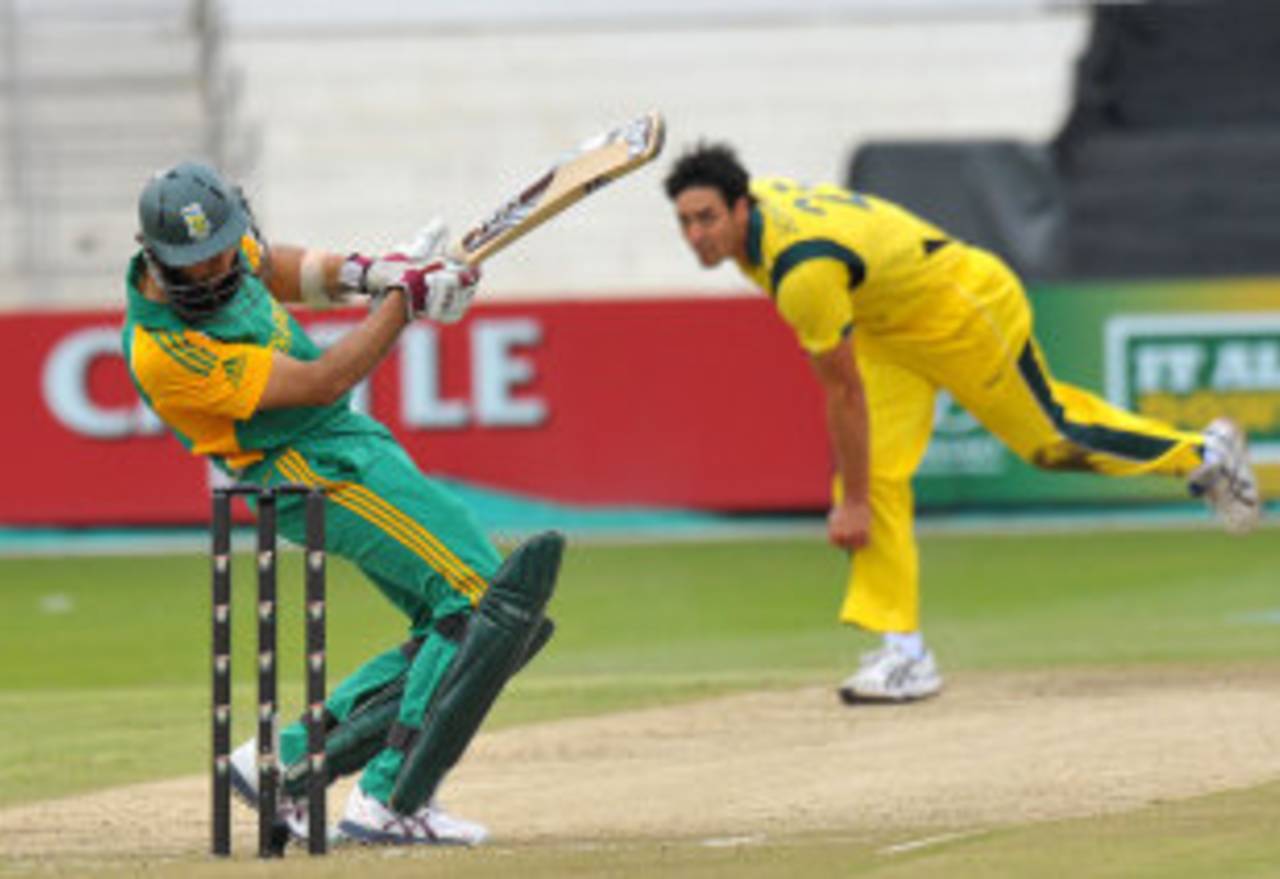The bowler runs in hard, sends down a bouncer and makes the batsman hop and duck. With his feet in the air from the hop, and his head tucked into his chest from the attempt at ducking, he manages to stay away from the line of the ball. The wicketkeeper, standing close to the 30-yard circle, makes a futile attempt to get an outstretched hand to the ball, which thuds into the sightscreen after bouncing once inside the rope.
The bowler is
Mitchell Johnson and the batsman Sanju Samson during a Champions League match in Jaipur.
The sight of a fast bowler making a batsman hop gets you to sit up and watch intently. And if the bowler makes some of the best batsmen in the world duck and sway on docile Indian pitches, you hold your breath in anticipation whenever that bowler runs in to bowl.
It's evident that Johnson has picked up his pace over the last year. And while the pace is visibly upsetting batsmen, the late inward movement into right-handers, and the bounce, are also playing havoc.
In the ODI series against India, Johnson has troubled the Indian batsmen with that extra bounce and pace, on pitches where totals of 300-plus have been par for the course. It's not that the Indians haven't faced this kind of pace or bounce; on the contrary, they have played it with authority and even dominated it in the past. But Johnson is a slightly different proposition.
He isn't the typical left-arm fast bowler who bowls with a high-arm action and relies mostly on exploiting the natural angle lefties create while bowling to right-handers. His bowling arm is some distance away from his left ear, and that makes it difficult for batsmen to gauge the bounce he will generate after pitching.
For bowlers with high-arm actions, the bounce off the surface is directly related to their point of release, which makes for a certain predictability. But with bowlers who have a slinging action, it's relatively difficult to assess how much bounce they'll get after pitching. Such bowlers skid the ball off the surface, unlike the ones with high-arm actions. When you bowl with a high-arm action the bounce you get is like that you get when a tennis ball bounces on a dry surface, and with a slingy action it's a bit like the bounce of a plastic ball on a wet surface.
Have you ever tried making a stone skip on water? The lower the arm while throwing, the more times the stone bounces off the surface of the water. Another key difference with regard to bounce is the trajectory of the ball after pitching - for bowlers with a high-arm action, the ball gains considerable height right after pitching, but for someone with a round-arm action, the path is more gradual, similar to an airplane taking off: it's not easy to gauge when the ball has reached the peak of its bounce. (This is why even wicketkeepers don't know how far back they should stand.)
A round-arm action puts severe pressure on the lower back and hips, which could lead to serious injuries. Mitchell Johnson's impact comes with a disclaimer: try to imitate it at your own peril
Then there's the small matter of whether the ball lands on the seam or on the shine. If it lands on the seam, it bounces considerably more than it would if it lands on the leather. When a bowler delivers with a round-arm action, even he can't be 100% sure of making the ball land on the seam, so what chance does the poor batsman have?
Johnson's natural bowling action is designed to make the ball curve in to the right-hand batsman, and when he's on top of his game (he has been there and thereabouts in this series), the ball comes in sharply. While the ball that moves laterally creates its own challenges - the batsman must not commit, must play close to the body and in the second line - in Johnson's case the ones that don't move create similar problems as well.
Given his round-arm action, which makes the ball curve in mostly, batsmen tend to play inside the line most times, so the ones that hold their line and go across cause trouble. When the ball doesn't come out right from Johnson's hand, it doesn't swing, and carries on across and away from the right-hander. Also, even when it comes out right, if Johnson has started a little too far outside off, the ball doesn't swing, and carries on across the right-hander. There's a thin line outside the right-hander's off stump that the bowler must stay within to make the ball curve in effectively. Johnson inadvertently crosses that line from time to time, keeping the batsman guessing.
Won't rookies be tempted to start out bowling with a round-arm, slingy action, given the obvious benefits of doing so? My advice in this regard is that it's important to know the flip side of such an action before taking the plunge. We only hear about the ones who have fought the odds and reached the top. It's important to know the rules to break them. Many bowlers with similar actions have ended up with severe back problems. A round-arm action puts severe pressure on the lower back and hips, which could lead to serious injuries. Also, it's not easy to be accurate regularly with such an action. Mitchell Johnson's impact comes with a disclaimer: try to imitate it at your own peril.
Former India opener Aakash Chopra is the author of Out of the Blue, an account of Rajasthan's 2010-11 Ranji Trophy victory. His website is here and his Twitter feed here
